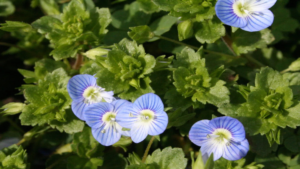Bird’s-eye Speedwell a charming wildflower or a lawn nuisance? Learn its identification, uses, and control methods for your garden.
Introduction: Bird’s Eye Speedwell
Have you noticed tiny, bright blue flowers dotting your lawn or garden beds? You might be looking at Bird’s-eye Speedwell (Veronica persica). This little plant with its striking flowers can spark debate – some find it a delightful wildflower, while others consider it an invasive weed. Let’s dive into everything you need to know about Bird’s-eye Speedwell in your garden.
Identifying Bird’s-eye Speedwell
- Appearance: This low-growing annual has trailing stems with rounded, slightly hairy leaves. Its star attraction is the petite but vibrant blue flower with a white center, resembling a bird’s eye.
- Bloom Time: Expect to see blooms from early spring through summer.
- Habitat: Bird’s-eye Speedwell thrives in lawns, gardens, fields, and disturbed areas. It likes moist conditions but tolerates various soil types.
Understanding Veronica Persica
Botanical Profile
Veronica Persica, a member of the Plantaginaceae family, is a flowering plant native to Eurasia that has naturalized throughout North America. It thrives in partial to full sun and moist conditions, although it’s quite adaptable to poor soil as well. This weedy annual is known for its vegetative growth during the cool weather of late winter or early spring, with blooming occurring from winter through early summer depending on the region.
Physical Characteristics
The Bird’s-Eye Speedwell is a ground cover species, growing horizontally and spreading across the ground with only the tips of its stems rising upright. It features hairy stems and leaves, with the broad, short-stalked leaves being broadly ovate and coarsely serrated. The flowers are a distinctive sky blue with darker stripes and a white center, measuring about 0.4 inches wide.
Cultivation and Care
Ideal Growing Conditions
For those looking to cultivate Veronica Persica, it’s important to mimic its preferred natural conditions. This means providing partial to full sun exposure, ensuring the soil remains moist, and opting for rich, loamy soil when possible.
Propagation Techniques
Propagation is typically done through seeds, with the plant reproducing annually. ‘Tidal Pool’ is a known cultivar variety that features blue petals with a white center, which could be a delightful addition to any garden.
Ecological Impact and Uses
As a Weed and Wildflower
While many consider Veronica Persica a weed due to its prolific nature and lack of agricultural use, it also plays a role as a wildflower, attracting bees and contributing to the ecosystem.
Medicinal and Historical Uses
Despite its reputation as a weed, Veronica Persica has been used for medicinal purposes, such as treating heart trouble and as an expectorant. Its historical significance is also notable, with legends tying it to St. Veronica.
What are the medicinal properties of veronica persica?

Veronica persica, commonly known as Persian speedwell, exhibits a range of medicinal properties that have been recognized in traditional and contemporary research. Its extracts are rich in phytoconstituents, including iridoid glycosides and phenolic compounds, which contribute to its therapeutic potential. Here are the key medicinal properties of Veronica persica:
- Antioxidant Activity: Veronica persica has demonstrated significant antioxidant effects, attributed to its content of iridoids and phenolic acids. These compounds are capable of scavenging free radicals, thereby protecting cells from oxidative stress and damage.
- Antimicrobial and Antifungal Properties: Extracts of Veronica persica have shown antibacterial and antifungal activities. It has been effective against a range of Gram-positive and Gram-negative bacteria, including strains that are resistant to conventional antibiotics. This suggests its potential as a natural alternative for treating infections.
- Anti-inflammatory Effects: The plant’s extracts have been found to possess anti-inflammatory properties, which align with its traditional use in treating inflammatory disorders. This makes it a candidate for natural treatments aimed at reducing inflammation.
- Scolicidal Activity: Veronica persica extract has demonstrated scolicidal activities, indicating its potential use in treating infections caused by Echinococcus granulosus, a parasite responsible for hydatid disease.
- Neuroprotective Potential: The plant’s extract has shown inhibitory activities against acetylcholinesterase and tyrosinase, enzymes involved in neurodegenerative diseases. This suggests its potential role in managing or preventing conditions such as Alzheimer’s disease.
- Anti-cancer Potential: While direct evidence of its anti-cancer effects is limited, the antioxidant and anti-inflammatory properties of Veronica persica may contribute to its potential in cancer prevention or as a complementary treatment.
- Liver Protection: Veronica persica has been reported to ameliorate acetaminophen-induced hepatotoxicity in mice, suggesting its protective effects on the liver. This is achieved through attenuating oxidative stress and inflammation, highlighting its potential in managing liver disorders.
- Wound Healing and Skin Care: Applied topically, Veronica persica has been used to treat wounds, skin problems, and itching. Its antioxidant and antimicrobial properties support skin health and promote healing.
In summary, Veronica persica exhibits a wide range of medicinal properties, including antioxidant, antimicrobial, anti-inflammatory, scolicidal, neuroprotective, and potential anti-cancer effects, along with liver protection and topical applications for skin health. These properties underscore its value in traditional medicine and its potential for further research and application in contemporary healthcare.
How to grow and care for birdeye speedwell?
To grow and care for Birdeye Speedwell (Veronica persica), it’s essential to provide the right conditions and maintenance to ensure healthy growth and flowering. Here are detailed guidelines based on the provided sources:
Light Requirements
Birdeye Speedwell thrives in abundant sunlight. It requires at least 6 to 8 hours of sunlight daily, with a preference for morning light, especially during the summer months. Place the plant less than one foot from a south-facing window to maximize its exposure to light when grown indoors.
Watering
The watering needs of Birdeye Speedwell vary depending on its growth stage and environmental conditions. Initially, while the seed germinates, the plant requires more frequent watering to maintain consistent soil moisture. Once established, it needs about 0.5 cups of water every 9 days if it doesn’t receive direct sunlight and is potted in a 5″ pot. Ensure the soil is well-drained and allow it to dry out between waterings.
Soil and Fertilization
Birdeye Speedwell does best in well-draining soil that contains organic matter such as coco coir, along with perlite or vermiculite to aid drainage. Regular potting soil with a handful of perlite usually suffices. The plant should be repotted after it doubles in size or once a year, whichever comes first. Fresh potting soil typically contains all the nutrients the plant needs, so additional fertilization is not necessary.
Temperature and Humidity
This plant prefers a temperature range of 68 to 95 °F (20 to 35 °C). During temperature extremes, it’s crucial to adjust conditions to mimic its preferred range. Birdeye Speedwell does not have specific humidity requirements but maintaining moderate humidity will support its growth.
Transplanting and Propagation
Transplant Birdeye Speedwell during the S1-S2 period to leverage optimal environmental conditions. Handle the plant gently to minimize root damage during the process. It reproduces by seed, so propagation is typically done through seeding.
General Care and Maintenance
Regularly check the plant for signs of distress such as yellowing or drooping leaves, which can indicate overwatering or nutrient deficiencies. Ensure the plant is getting the right amount of light, as too much or too little can stress it. Removing spent flower heads will prolong the blooming period.
Troubleshooting
Start by checking the soil moisture and ensuring the plant is receiving the correct amount of light. Adjust care routines accordingly if the plant appears sad or unhealthy.By following these guidelines, you can successfully grow and care for Birdeye Speedwell, enjoying its beautiful blooms and lush foliage.
What are the common names for veronica persica?
Veronica persica is known by several common names, including:
- Birdeye Speedwell
- Common Field-Speedwell
- Persian Speedwell
- Large Field Speedwell
- Bird’s-Eye
- Winter Speedwell.
Conclusion
Veronica Persica, or Bird’s-Eye Speedwell, is more than just a common weed. Its resilience, beauty, and historical significance make it a noteworthy plant for both its aesthetic and functional value. Whether you’re looking to add a splash of blue to your garden or explore its medicinal properties, Bird’s-Eye Speedwell is a plant that deserves a second look.

I do not even know how I ended up here but I thought this post was great I dont know who you are but definitely youre going to a famous blogger if you arent already Cheers
Thank you so much for your kind words and enthusiasm! It’s incredibly motivating to hear that the content has resonated with you so strongly.
I was recommended this website by my cousin I am not sure whether this post is written by him as nobody else know such detailed about my trouble You are amazing Thanks
Fantastic beat I would like to apprentice while you amend your web site how could i subscribe for a blog site The account helped me a acceptable deal I had been a little bit acquainted of this your broadcast offered bright clear concept
Fantastic site A lot of helpful info here Im sending it to some buddies ans additionally sharing in delicious And naturally thanks on your sweat
Thanks I have just been looking for information about this subject for a long time and yours is the best Ive discovered till now However what in regards to the bottom line Are you certain in regards to the supply
Wow amazing blog layout How long have you been blogging for you made blogging look easy The overall look of your web site is magnificent as well as the content
Normally I do not read article on blogs however I would like to say that this writeup very forced me to try and do so Your writing style has been amazed me Thanks quite great post
I have read some excellent stuff here Definitely value bookmarking for revisiting I wonder how much effort you put to make the sort of excellent informative website
La weekly I do not even understand how I ended up here, but I assumed this publish used to be great
Techno rozen Good post! We will be linking to this particularly great post on our site. Keep up the great writing
Mygreat learning I just like the helpful information you provide in your articles
Simply wish to say your article is as amazing. The clearness in your post is just nice and i could assume you’re an expert on this subject. Well with your permission let me to grab your feed to keep updated with forthcoming post. Thanks a million and please carry on the gratifying work.
I’m really glad to hear that my article helped you feel hopeful!
I loved as much as you will receive carried out right here The sketch is attractive your authored material stylish nonetheless you command get got an impatience over that you wish be delivering the following unwell unquestionably come more formerly again since exactly the same nearly a lot often inside case you shield this hike
I’m really glad to hear that my article helped you feel hopeful!